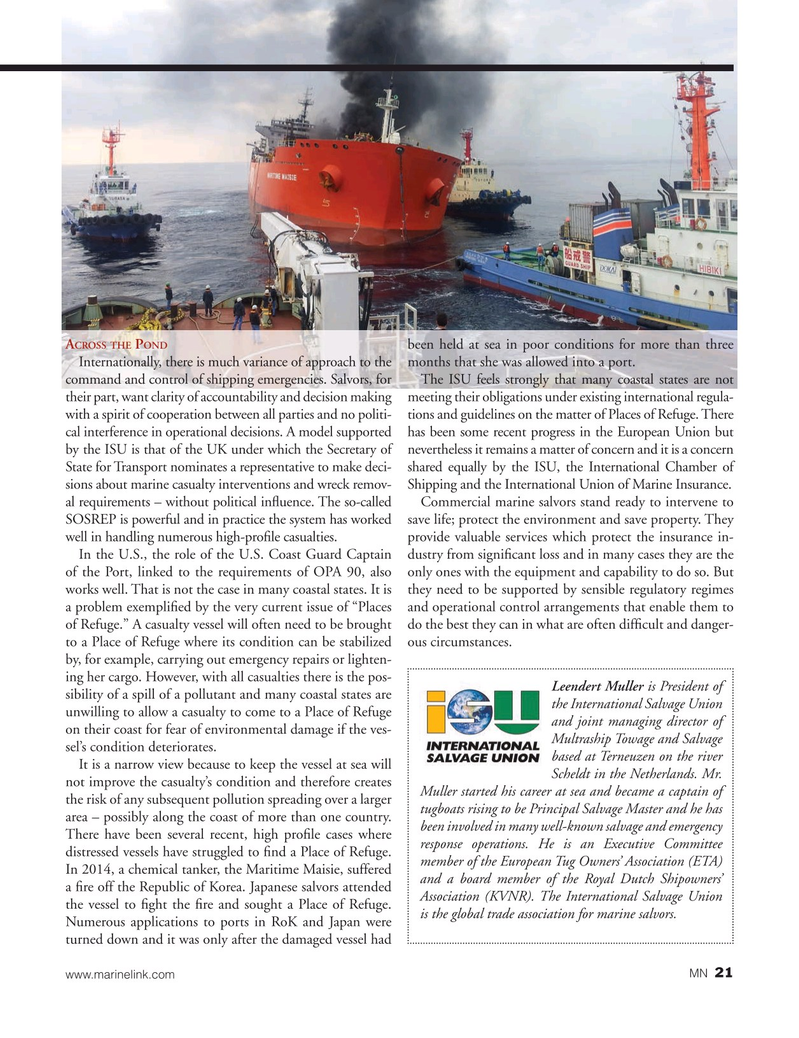
Page 21: of Marine News Magazine (October 2015)
Salvage & Spill Response
Read this page in Pdf, Flash or Html5 edition of October 2015 Marine News Magazine
A P been held at sea in poor conditions for more than three
CROSS THE OND
Internationally, there is much variance of approach to the months that she was allowed into a port.
command and control of shipping emergencies. Salvors, for The ISU feels strongly that many coastal states are not their part, want clarity of accountability and decision making meeting their obligations under existing international regula- with a spirit of cooperation between all parties and no politi- tions and guidelines on the matter of Places of Refuge. There cal interference in operational decisions. A model supported has been some recent progress in the European Union but by the ISU is that of the UK under which the Secretary of nevertheless it remains a matter of concern and it is a concern
State for Transport nominates a representative to make deci- shared equally by the ISU, the International Chamber of sions about marine casualty interventions and wreck remov- Shipping and the International Union of Marine Insurance.
al requirements – without political in? uence. The so-called Commercial marine salvors stand ready to intervene to
SOSREP is powerful and in practice the system has worked save life; protect the environment and save property. They well in handling numerous high-pro? le casualties. provide valuable services which protect the insurance in-
In the U.S., the role of the U.S. Coast Guard Captain dustry from signi? cant loss and in many cases they are the of the Port, linked to the requirements of OPA 90, also only ones with the equipment and capability to do so. But works well. That is not the case in many coastal states. It is they need to be supported by sensible regulatory regimes a problem exempli? ed by the very current issue of “Places and operational control arrangements that enable them to of Refuge.” A casualty vessel will often need to be brought do the best they can in what are often dif? cult and danger- to a Place of Refuge where its condition can be stabilized ous circumstances.
by, for example, carrying out emergency repairs or lighten- ing her cargo. However, with all casualties there is the pos-
Leendert Muller is President of sibility of a spill of a pollutant and many coastal states are the International Salvage Union unwilling to allow a casualty to come to a Place of Refuge and joint managing director of on their coast for fear of environmental damage if the ves-
Multraship Towage and Salvage sel’s condition deteriorates.
based at Terneuzen on the river
It is a narrow view because to keep the vessel at sea will
Scheldt in the Netherlands. Mr. not improve the casualty’s condition and therefore creates
Muller started his career at sea and became a captain of the risk of any subsequent pollution spreading over a larger tugboats rising to be Principal Salvage Master and he has area – possibly along the coast of more than one country. been involved in many well-known salvage and emergency
There have been several recent, high pro? le cases where response operations. He is an Executive Committee distressed vessels have struggled to ? nd a Place of Refuge. member of the European Tug Owners’ Association (ETA)
In 2014, a chemical tanker, the Maritime Maisie, suffered and a board member of the Royal Dutch Shipowners’ a ? re off the Republic of Korea. Japanese salvors attended
Association (KVNR). The International Salvage Union the vessel to ? ght the ? re and sought a Place of Refuge. is the global trade association for marine salvors.
Numerous applications to ports in RoK and Japan were turned down and it was only after the damaged vessel had 21
MN www.marinelink.com
MN Oct15 Layout 18-31.indd 21 9/21/2015 11:08:41 AM

 20
20

 22
22
